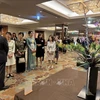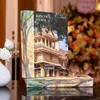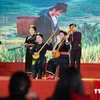Two wooden anchors retrieved from the Red River and possessed by a restaurant owner in Hanoi has received a lot of attention of domestic and foreign archaeologists for their historical value, according to radio The Voice of Vietnam (VOV).
Quach Van Dich, proprietor of a beer garden in Chuong Duong Ward near the Red River, recalled that he bought a two-arm wooden anchor from a fisherman near the bank of the Red River on a summer day in 1999.
The strange anchor surprised Dich at first sight. Its central shank was nearly 10m long. Two arms carrying flukes were attached to the shank by a steel belt and tied by a shabby robe.
Dich thought the anchor might have been erected at the entrance gate of the Red River wharf to attract travellers on a river tour. Examining the wooden object carefully, he found it had the dark-grey colour that aroused his curiosity.
He intended to buy that piece of log to display inside his restaurant as a way to do PR, and he got the nod from the fisherman.
In late 1999, a strange man came to Dich’s restaurant and offered him another wooden anchor which had only one arm. Dich agreed to buy it and displayed together with the previous one in his house.
The value of the two anchors was disclosed after a Chinese man came to Dich’s restaurant in 2002, expressing a desire to purchase the two-arm anchor at 30,000 USD. Dich just smiled and thought the Chinese man was making a joke.
After travelling to Ho Chi Minh City for several days, the Chinese tourist returned and upped the offer to 150,000 USD.
To Dich’s surprise, it was too good to miss, but he refused again. He speculated that it might have been an antique of great historical significance; it was not simply an inanimate object retrieved from the river seabed.
He immediately contacted leading Vietnamese historian Duong Trung Quoc and sent photographs of the anchors to him. In an attached letter, he described in detail where he bought them and asked the historian for assistance in researching the matter.
Two days later, historian Quoc and his colleague archaeologist Dr Vu The Long from the Vietnam Archaeology Academy arrived at Dich’s door.
They were all surprised by the discovery of two strange anchors, and vowed to uncover the truth with the assistance of the world’s latest technology and foreign experts.
Long hypothesised that the anchors quite possibly came from Chinese war ships sunk in the Bach Dang River (another river running in the north of Vietnam) during the 13th and 15th centuries when the Mongol invaders attacked the country.
A group of six archaeological experts from the Institute of Nautical Archaeology (INA) of the US and Flinders University of Australia were invited to Dich’s house to find out the origin of the anchors.
They made a fact-finding tour of Bai Coc – an area full of iron-tipped stakes used to resist Mongol invaders during the battle of Bach Dang in Quang Ninh province. They also visited Bach Dang museum in Quang Ninh and History Museum in Hanoi, trying to find archaeological traces of the anchors.
Randall Sasaki, a PhD student of INA, said the group will assist Vietnam in research methodology and even call for funding to work on this project.
Jun Kimura, a PhD research student of Flinders University, thought Dich’s anchors had been made long before similar wooden anchors were retrieved in Japan in 1994.
Dich was happy about experts’ comments because he was aware that he was possessing unique objects of great historical value.-VNA
Quach Van Dich, proprietor of a beer garden in Chuong Duong Ward near the Red River, recalled that he bought a two-arm wooden anchor from a fisherman near the bank of the Red River on a summer day in 1999.
The strange anchor surprised Dich at first sight. Its central shank was nearly 10m long. Two arms carrying flukes were attached to the shank by a steel belt and tied by a shabby robe.
Dich thought the anchor might have been erected at the entrance gate of the Red River wharf to attract travellers on a river tour. Examining the wooden object carefully, he found it had the dark-grey colour that aroused his curiosity.
He intended to buy that piece of log to display inside his restaurant as a way to do PR, and he got the nod from the fisherman.
In late 1999, a strange man came to Dich’s restaurant and offered him another wooden anchor which had only one arm. Dich agreed to buy it and displayed together with the previous one in his house.
The value of the two anchors was disclosed after a Chinese man came to Dich’s restaurant in 2002, expressing a desire to purchase the two-arm anchor at 30,000 USD. Dich just smiled and thought the Chinese man was making a joke.
After travelling to Ho Chi Minh City for several days, the Chinese tourist returned and upped the offer to 150,000 USD.
To Dich’s surprise, it was too good to miss, but he refused again. He speculated that it might have been an antique of great historical significance; it was not simply an inanimate object retrieved from the river seabed.
He immediately contacted leading Vietnamese historian Duong Trung Quoc and sent photographs of the anchors to him. In an attached letter, he described in detail where he bought them and asked the historian for assistance in researching the matter.
Two days later, historian Quoc and his colleague archaeologist Dr Vu The Long from the Vietnam Archaeology Academy arrived at Dich’s door.
They were all surprised by the discovery of two strange anchors, and vowed to uncover the truth with the assistance of the world’s latest technology and foreign experts.
Long hypothesised that the anchors quite possibly came from Chinese war ships sunk in the Bach Dang River (another river running in the north of Vietnam) during the 13th and 15th centuries when the Mongol invaders attacked the country.
A group of six archaeological experts from the Institute of Nautical Archaeology (INA) of the US and Flinders University of Australia were invited to Dich’s house to find out the origin of the anchors.
They made a fact-finding tour of Bai Coc – an area full of iron-tipped stakes used to resist Mongol invaders during the battle of Bach Dang in Quang Ninh province. They also visited Bach Dang museum in Quang Ninh and History Museum in Hanoi, trying to find archaeological traces of the anchors.
Randall Sasaki, a PhD student of INA, said the group will assist Vietnam in research methodology and even call for funding to work on this project.
Jun Kimura, a PhD research student of Flinders University, thought Dich’s anchors had been made long before similar wooden anchors were retrieved in Japan in 1994.
Dich was happy about experts’ comments because he was aware that he was possessing unique objects of great historical value.-VNA



















